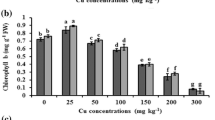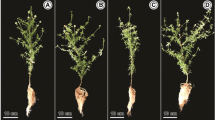Abstract
Phytoextraction is a remediation technology with a promising application for removing arsenic (As) from soils and waters. Several plant species were evaluated for their As accumulation capacity in hydroponic culture amended with As. Cucumis sativus (cucumber) displayed the highest tolerance against As among 4 plants tested in this study (corn, wheat, sorghum and cucumber). The germination ratio of Cucumis sativus was more than 50% at the high concentration of 5,000 mg-As/l. In Cucumis sativus grown in a solution contaminated with 25 mg-As/l, the accumulated As concentrations in the shoot and root were 675.5 ± 11.5 and 312.0 ± 163.4 mg/kg, respectively, and the corresponding values of the translocation and bioaccumulation factors for As were 1.9 ± 0.9 and 21.1 ± 8.4, respectively. These results indicate Cucumis sativus is to be a candidate plant for phytoextraction of As from soils and water.





Similar content being viewed by others
References
An, Y. J. (2004). Soil ecotoxicity assessment using cadmium sensitive plant. Environmental Pollution, 127, 21–26.
Burló, F., Guijarro, I., Carbonell-Barrachina, A. A., Valero, D., & Martinez-Sánchez, F. (1999). Arsenic species: effects on and accumulation by tomato plants. Journal of Agricultural Food and Chemistry, 47, 1247–1253.
Carbonell-Barrachina, A. A., Aarabi, M. A., DeLaune, R. D., Gambrell, R. P., & Patrick, W. H. (1998). The influence of arsenic chemical form and concentration on Spartina patens and Spartina alterniflora growth and tissue arsenic concentration. Plant and Soil, 198, 33–43.
Chintakovid, W., Visoottiviseth, P., Khokiattiwong, S., & Lauengsuchonkul, S. (2008). Potential of the hybrid marigolds for arsenic phytoremediation and income generation of remediators in Ron Phibun District, Thailand. Chemosphere, 70, 1532–1537.
Chopra, B. K., Bhat, S., Mikheenko, I. P., Xu, Z., Yang, Y., Luo, X., et al. (2007). The characteristics of rhizosphere microbes associated with plants in arsenic-contaminated soils from cattle dip sites. Science of the Total Environment, 378, 331–342.
Fayiga, A. O., Ma, L. Q., Santoa, J., Rathinasabapathi, B., Stamps, B., & Littell, R. C. (2005). Effects of arsenic species and concentrations on arsenic accumulation by different fern species in a hydroponic system. International Journal of Phytoremediation, 7, 231–240.
Fitz, W. J., & Wenzel, W. W. (2002). Arsenic transformations in the soil-rhizosphere plant system: Fundamentals and potential application to phytoremediation. Journal of Biotechnology, 99, 259–278.
Francesconi, K. A., & Kuehnelt, D. (2002). Arsenic compound in the environment. In W. T. Frankenberger Jr (Ed.), Environmental chemistry of arsenic (pp. 51–94). New York: Marcel Dekker.
Francesconi, K., Visoottiviseth, P., Sridokchan, W., & Goessler, W. (2002). Arsenic species in an arsenic hyperaccumulating fern, Pityrogramma calomelanos, a potential phytoremediator of arsenic-contaminated soils. Science of the Total Environment, 284, 27–35.
Gisbert, C., Almela, C., Vélez, D., López-Moya, J. R., Haro, A., Serrano, R., et al. (2008). Identification of as accumulation plant species growing on highly contaminated soils. International Journal of Phytoremediation, 10, 185–196.
Haque, N., Peralta-Videa, J. R., Jones, G. L., Gill, T. E., & Gardea-Torresdey, J. L. (2007). Screening the phytoremediation potential of desert broom (Baccharis sarothroides Gray) growing on mine tailings in Arizona, USA. Environmental Pollution, 153, 362–368.
Kertulis-Tartar, G. M., Ma, L. Q., Tu, C., & Chirenje, T. (2006). Phytoremediation of an arsenic-contaminated site using Pteris vittata: A two-year study. International Journal of Phytoremediationion, 8, 311–322.
Ma, L. Q., Komar, K. M., Zhang, W., Cai, Y., & Kennelley, E. D. (2001). A fern that hyper accumulates arsenic. Nature, 409, 579.
Ma, J. F., Yamaji, N., Mitani, N., Xu, X. Y., Su, Y. H., McGrath, S. P., et al. (2008). Transporters of arsenite in rice and their role in arsenic accumulation in rice grain. Proceedings of the National Academy of Sciences, USA, 105, 9931–9935.
Mandal, B. K., & Suzuki, K. T. (2002). Arsenic around the world: A review. Talanta, 58, 201–235.
Marin, A. R., Masscheleyn, P. H., & Patrick, W. H. (1992). The influence of chemical form and concentration of arsenic on rice growth and tissue arsenic concentration. Plant and Soil, 139, 175–183.
Marques, A. P. G. C., Moreira, H., Rangel, A. O. S. S., & Castro, P. M. L. (2008). Arsenic, lead and nickel accumulation in Rubus ulmifolius growing in contaminated soil in Portugal. Journal of Hazardous Materials, 165, 174–179.
McGrath, S. P., Chaudri, A. M., & Giller, K. E. (1995). Long-term effects of metals in sewage sludge on soils, microorganisms and plants. Journal of Industrial Microbiology & Biotechnology, 14, 94–104.
Meharg, A. A., & Hartley-Whitaker, J. (2002). Arsenic uptake and metabolism in arsenic resistant and nonresistant plant species. New Phytologist, 154, 29–43.
Melo, E. E. C., Costa, E. T. S., Guilhermea, L. R. G., Faquina, V., & Nascimentob, C. W. A. (2009). Accumulation of arsenic and nutrients by castor bean plants grown on an As-enriched nutrient solution. Journal of Hazardous Materials, 168, 479–483.
Mihucz, V. G., Tatar, E., Virag, I., Cseh, E., Fodor, F., & Zaray, G. (2005). Arsenic speciation in xylem sap of cucumber (Cucumis sativus L.). Analytical and Bioanalytical Chemistry, 383, 461–466.
Pickering, I. J., Prince, R. C., George, M. J., Smith, R. D., George, G. N., & Salt, D. E. (2000). Reduction and coordination of arsenic in Indian mustard. Plant Physiology, 122, 1171–1177.
Rahman, M. A., Hasegawa, H., Ueda, K., Maki, O. C., & Rahman, M. M. (2007). Arsenic accumulation in duckweed (Spirodela polyrhiza L.): A good option for phytoremediation. Chemosphere, 69, 493–499.
Rajkumar, M., Nagendran, R., Lee, K. J., Lee, W. H., & Kim, S. Z. (2005). Influence of plant growth promoting bacteria and Cr6+ on the growth of Indian mustard. Chemosphere, 62, 741–748.
Robinson, B., Kim, N., Marchetti, M., Moni, C., Schroeter, L., Dijssel, C. V. D., et al. (2006). Arsenic hyperaccumulation by aquatic macrophytes in the Taupo Volcanic Zone, New Zealand. Environmental and Experimental Botany, 58, 206–215.
Ruby, M. V., Davis, A., Schoof, R., Eberle, S., & Sellstone, C. M. (1996). Estimation of lead and arsenic bioavailability using a physiologically based extraction test. Environmental Science and Technology, 30, 422–430.
Sracek, O., Bhattacharya, P., Jacks, G., Gustafsson, J. P., & von Bromeesn, M. (2004). Behavior of arsenic and geochemical modeling of arsenic enrichment in aqueous environments. Applied Geochemistry, 19, 169–180.
Su, Y. H., McGrath, S. P., Zhu, Y. G., & Zhao, F. J. (2008). Highly efficient xylem transport of arsenite in the arsenic hyperaccumulator Pteris vittata. New Phytologist, 180, 434–441.
Sun, Y., Zhou, Q., & Diao, C. (2008). Effects of cadmium and arsenic on growth and metal accumulation of Cd-hyperaccumulator Solanum nigrum L. Bioresource Technology, 99, 1103–1110.
Tu, S., Ma, L. Q., & Bondada, B. (2002). Arsenic accumulation in the hyperaccumulator Chinese Brake and its utilisation potential for phytoremediation. Journal of Environmental Quality, 31, 1671–1675.
Tu, C., Ma, L. Q., & Luongo, T. (2004). Root exudates and arsenic accumulation in arsenic hyperaccumulating Pteris vittata and non-hyperaccumulating Nephrolepis exaltata. Plant and Soil, 258, 9–19.
Wei, C. Y., Wang, C., & Sun, X. (2007). Arsenic accumulation by ferns: A field survey in southern china. Environmental Geochemistry and Health, 29, 169–177.
Xu, X. Y., McGrath, S. P., Meharg, A., & Zhao, F. J. (2007). Growing rice aerobically markedly decreases arsenic accumulation. Environmental Science and Technology, 42, 5574–5579.
Zabłudowska, E., Kowalska, J., Jedynak, L., Wojas, S., Skłodowska, A., & Antosiewicz, D. M. (2009). Search for a plant for phytoremediation–What can we learn from field and hydroponic studies? Chemosphere, 77, 301–307.
Zhao, R., Zhao, M., Wang, H., Taneike, Y., & Zhang, X. (2006). Arsenic speciation in moso bamboo shoot–a terrestrial plant that contains organoarsenic species. Science of the Total Environment, 371, 293–303.
Zhao, F. J., Ma, J. F., Meharg, A. A., & McGrath, S. P. (2009). Arsenic uptake and metabolism in plants. New Phytologist, 181, 777–794.
Zhu, Y. G., & Rosen, B. P. (2009). Perspectives for genetic engineering for the phytoremediation of arsenic-contaminated environments: From imagination to reality? Current Opinion in Biotechnology, 20, 220–224.
Zhu, Y. G., Williams, P. N., & Meharg, A. A. (2008). Exposure to inorganic arsenic from rice: A global issue. Environmental Pollution, 154, 169–171.
Acknowledgments
This research was supported by the National Research Foundation of Korea (NRF) funded by the Ministry of Education, Science and Technology (MEST) (KRF-2008-C00388). Sun Ah Choi was financially supported through NRL program (R0A-2008-000-20044-0) by the NRF, MEST.
Author information
Authors and Affiliations
Corresponding author
Rights and permissions
About this article
Cite this article
Hong, S.H., Choi, S.A., Yoon, H. et al. Screening of Cucumis sativus as a new arsenic-accumulating plant and its arsenic accumulation in hydroponic culture. Environ Geochem Health 33 (Suppl 1), 143–149 (2011). https://doi.org/10.1007/s10653-010-9350-6
Received:
Accepted:
Published:
Issue Date:
DOI: https://doi.org/10.1007/s10653-010-9350-6




